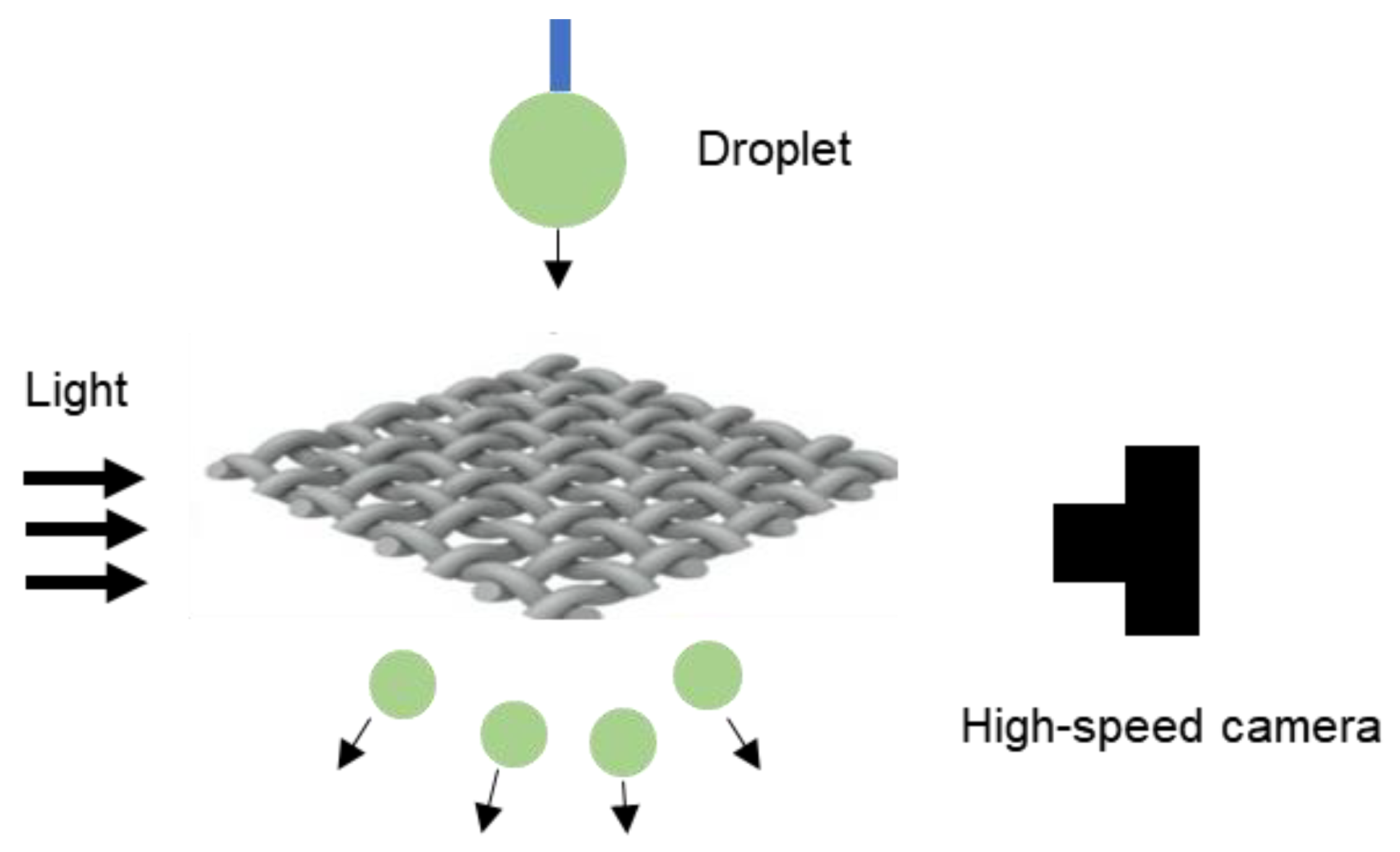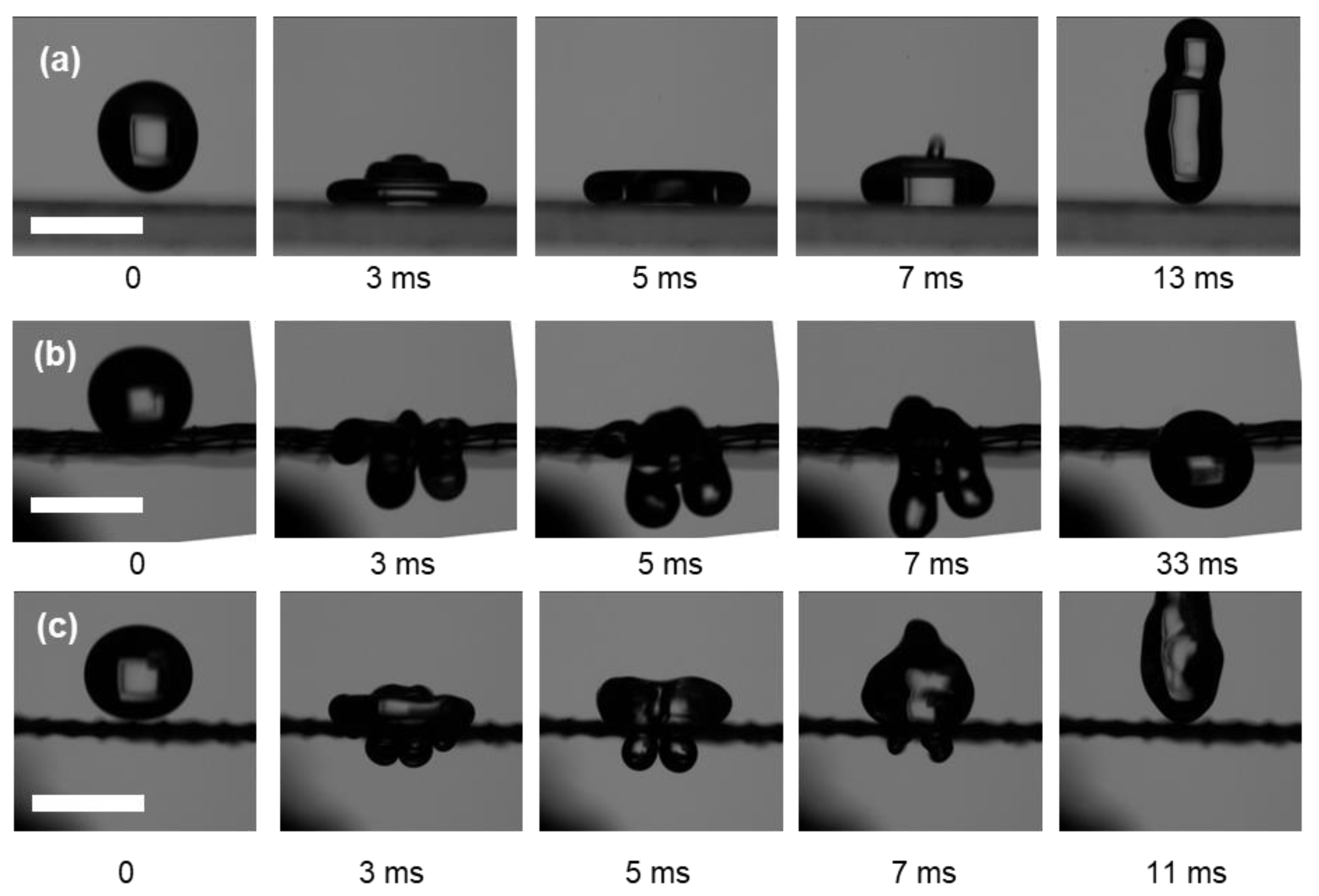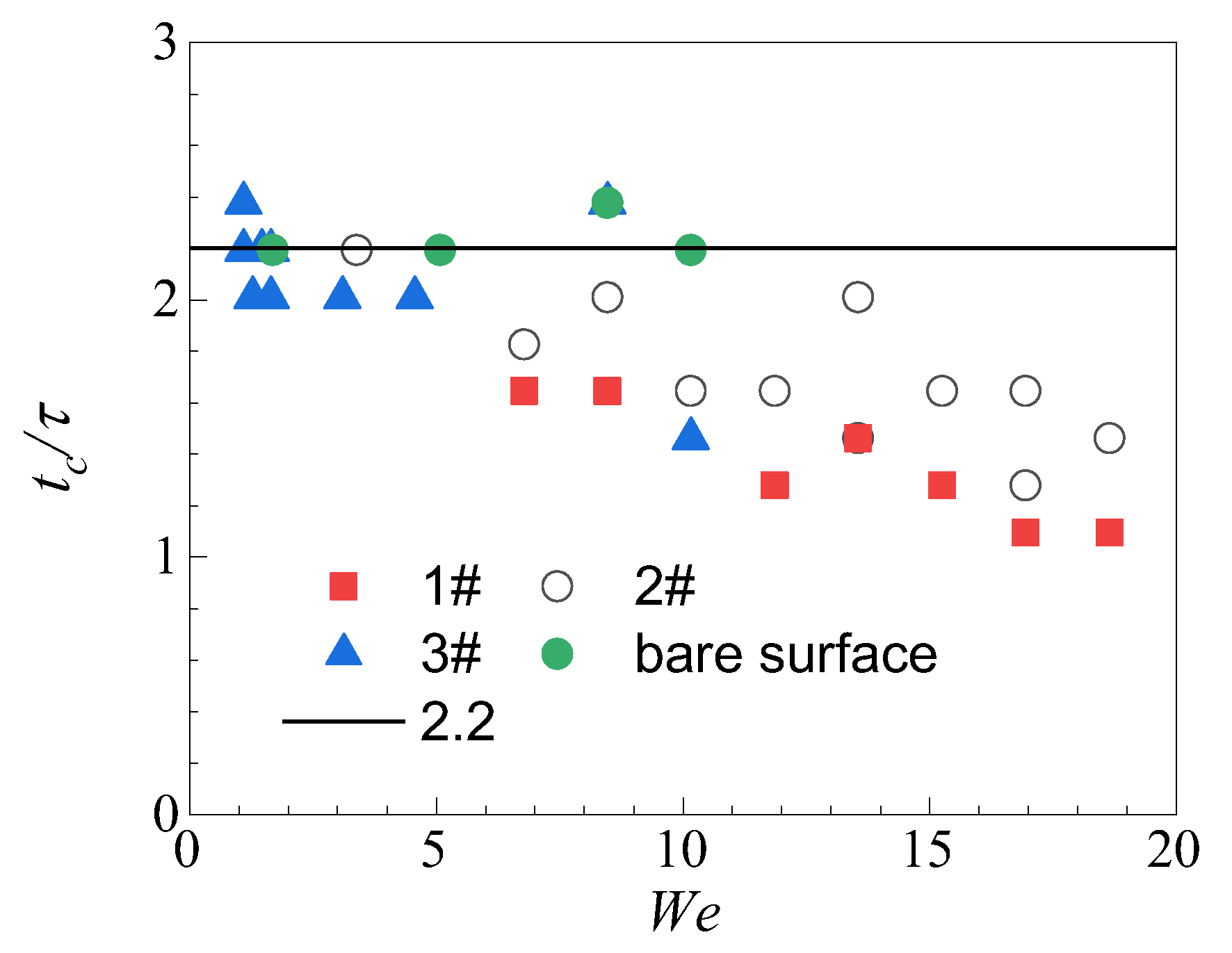Experimental Investigation on the Droplet Stability of Superhydrophobic Mesh
Abstract
:1. Introduction
2. Experimental Setup
2.1. Modification of the Wettability of the Mesh
2.2. Experimental Setup for Tests of an Impacting Droplet on a Superhydrophobic Mesh
3. Results and Discussion
3.1. Impacting Process of a Droplet on Different Substrates
3.2. Stability of Impacting Water on Superhydrophobic Mesh
3.3. Contact Time of Droplet on the Superhydrophobic Mesh
4. Conclusions
Supplementary Materials
Author Contributions
Funding
Institutional Review Board Statement
Informed Consent Statement
Data Availability Statement
Conflicts of Interest
References
- Neinhuis, C.; Barthlott, W. Characterization and distribution of water-repellent, self-cleaning plant surfaces. Ann. Bot. 1997, 79, 667–677. [Google Scholar] [CrossRef] [Green Version]
- Cassie, A.; Baxter, S. Wettability of porous surfaces. Trans. Faraday Soc. 1944, 40, 546–551. [Google Scholar] [CrossRef]
- Erdene-Ochir, O.; Chun, D.-M. Robust Superhydrophobic Surface on Polypropylene with Thick Hydrophobic Silica Nanoparticle-Coated Films Prepared by Facile Compression Molding. Energies 2021, 14, 3155. [Google Scholar] [CrossRef]
- Emami, B.; Vahedi Tafreshi, H.; Gad-el-Hak, M.; Tepper, G.C. Predicting shape and stability of air–water interface on superhydrophobic surfaces comprised of pores with arbitrary shapes and depths. Appl. Phys. Lett. 2012, 100, 013104. [Google Scholar] [CrossRef] [Green Version]
- Song, D.; Song, B.; Hu, H.; Du, X.; Du, P.; Choi, C.-H.; Rothstein, J.P. Effect of a surface tension gradient on the slip flow along a superhydrophobic air-water interface. Phys. Rev. Fluids 2018, 3, 033303. [Google Scholar] [CrossRef]
- Rothstein, J.P. Slip on Superhydrophobic Surfaces. Annu. Rev. Fluid Mech. 2010, 42, 89–109. [Google Scholar] [CrossRef]
- Srinivasan, S.; Kleingartner, J.A.; Gilbert, J.B.; Cohen, R.E.; Milne, A.J.B.; McKinley, G.H. Sustainable Drag Reduction in Turbulent Taylor-Couette Flows by Depositing Sprayable Superhydrophobic Surfaces. Phys. Rev. Lett. 2015, 114, 014501. [Google Scholar] [CrossRef] [Green Version]
- Aljallis, E.; Sarshar, M.A.; Datla, R.; Sikka, V.; Jones, A.; Choi, C.-H. Experimental study of skin friction drag reduction on superhydrophobic flat plates in high Reynolds number boundary layer flow. Phys. Fluids 2013, 25, 025103. [Google Scholar] [CrossRef]
- Ou, J.; Perot, B.; Rothstein, J.P. Laminar drag reduction in microchannels using ultrahydrophobic surfaces. Phys. Fluids 2004, 16, 4635–4643. [Google Scholar] [CrossRef] [Green Version]
- Srinivasan, S.; Choi, W.; Park, K.C.; Chhatre, S.S.; Cohen, R.E.; McKinley, G.H. Drag reduction for viscous laminar flow on spray-coated non-wetting surfaces. Soft Matter 2013, 9, 5691–5702. [Google Scholar] [CrossRef] [Green Version]
- Choi, C.H.; Ulmanella, U.; Kim, J.; Ho, C.M.; Kim, C.J. Effective slip and friction reduction in nanograted superhydrophobic microchannels. Phys. Fluids 2006, 18, 087105. [Google Scholar] [CrossRef] [Green Version]
- Song, D.; Daniello, R.J.; Rothstein, J.P. Drag reduction using superhydrophobic sanded Teflon surfaces. Exp. Fluids 2014, 55, 1783. [Google Scholar] [CrossRef]
- Hoai Thanh, N.; Chang, K.; Lee, S.-W.; Ryu, J.; Kim, M. Numerical Prediction of Turbulent Drag Reduction with Different Solid Fractions and Distribution Shapes over Superhydrophobic Surfaces. Energies 2022, 15, 6645. [Google Scholar]
- Yang, Q.; Sun, P.Z.; Fumagalli, L.; Stebunov, Y.V.; Haigh, S.J.; Zhou, Z.W.; Grigorieva, I.V.; Wang, F.C.; Geim, A.K. Capillary condensation under atomic-scale confinement. Nature 2020, 588, 250–253. [Google Scholar] [CrossRef]
- Jiang, M.; Wang, Y.; Liu, F.; Du, H.; Li, Y.; Zhang, H.; To, S.; Wang, S.; Pan, C.; Yu, J. Inhibiting the Leidenfrost effect above 1,000° C for sustained thermal cooling. Nature 2022, 601, 568–572. [Google Scholar] [CrossRef]
- Cui, J.; Cui, Y. Effects of Surface Wettability and Roughness on the Heat Transfer Performance of Fluid Flowing through Microchannels. Energies 2015, 8, 5704–5724. [Google Scholar] [CrossRef] [Green Version]
- Okulov, V.; Kabardin, I.; Mukhin, D.; Stepanov, K.; Okulova, N. Physical De-Icing Techniques for Wind Turbine Blades. Energies 2021, 14, 6750. [Google Scholar] [CrossRef]
- Yarin, A.L. Drop impact dynamics: Splashing, spreading, receding, bouncing…. Annu. Rev. Fluid Mech. 2006, 38, 159–192. [Google Scholar] [CrossRef]
- Zhang, X.; Zhu, Z.; Zhang, C.; Yang, C. Reduced contact time of a droplet impacting on a moving superhydrophobic surface. Appl. Phys. Lett. 2020, 117, 151602. [Google Scholar] [CrossRef]
- Song, D.; Bhushan, B. Optimization of bioinspired triangular patterns for water condensation and transport. Philos. Trans. R. Soc. A Math. Phys. Eng. Sci. 2019, 377, 20190127. [Google Scholar] [CrossRef] [Green Version]
- Song, D.; Bhushan, B. Bioinspired triangular patterns for water collection from fog. Philos. Trans. R. Soc. A Math. Phys. Eng. Sci. 2019, 377, 20190128. [Google Scholar] [CrossRef] [PubMed] [Green Version]
- Song, D.; Jiang, Y.; Chou, T.; Asawa, K.; Choi, C.-H. Spontaneous Deicing on Cold Surfaces. Langmuir 2020, 36, 11245–11254. [Google Scholar] [CrossRef]
- Xing, S.; Jiang, J.; Pan, T. Interfacial microfluidic transport on micropatterned superhydrophobic textile. Lab Chip 2013, 13, 1937–1947. [Google Scholar] [CrossRef]
- Vinogradova, O.I.; Dubov, A.L. Superhydrophobic textures for microfluidics. Mendeleev Commun. 2012, 22, 229–236. [Google Scholar] [CrossRef]
- Lei, S.; Fang, X.; Wang, F.; Xue, M.; Ou, J.; Li, C.; Li, W. A facile route to fabricate superhydrophobic Cu2O surface for efficient oil–water separation. Coatings 2019, 9, 659. [Google Scholar] [CrossRef] [Green Version]
- Chen, Y.; Yang, S.; Zhang, Q.; Zhang, D.; Yang, C.; Wang, Z.; Wang, R.; Song, R.; Wang, W.; Zhao, Y. Effects of Surface Microstructures on Superhydrophobic Properties and Oil-Water Separation Efficiency. Coatings 2019, 9, 69. [Google Scholar] [CrossRef] [Green Version]
- Wang, C.-F.; Tsai, Y.-J.; Kuo, S.-W.; Lee, K.-J.; Hu, C.-C.; Lai, J.-Y. Toward superhydrophobic/superoleophilic materials for separation of oil/water mixtures and water-in-oil emulsions using phase inversion methods. Coatings 2018, 8, 396. [Google Scholar] [CrossRef] [Green Version]
- Xue, Z.; Cao, Y.; Liu, N.; Feng, L.; Jiang, L. Special wettable materials for oil/water separation. J. Mater. Chem. A 2014, 2, 2445–2460. [Google Scholar] [CrossRef]
- Ren, G.; Song, Y.; Li, X.; Zhou, Y.; Zhang, Z.; Zhu, X. A superhydrophobic copper mesh as an advanced platform for oil-water separation. Appl. Surf. Sci. 2018, 428, 520–525. [Google Scholar] [CrossRef]
- Ammann, S.; Ammann, A.; Ravotti, R.; Fischer, L.J.; Stamatiou, A.; Worlitschek, J. Effective Separation of a Water in Oil Emulsion from a Direct Contact Latent Heat Storage System. Energies 2018, 11, 2264. [Google Scholar] [CrossRef] [Green Version]
- Yuan, J.; Cui, C.; Qi, B.; Wei, J.; Qaisrani, M.A. Experimental Investigation of Copper Mesh Substrate with Selective Wettability to Separate Oil/Water Mixture. Energies 2019, 12, 4564. [Google Scholar] [CrossRef] [Green Version]
- Kang, J.H.; Lee, J.-W.; Kim, J.Y.; Moon, J.W.; Jang, H.S.; Jung, S.Y. Effect of mesh wettability modification on atmospheric and industrial fog harvesting. Front. Phys. 2021, 9, 680641. [Google Scholar] [CrossRef]
- Song, D.; Song, B.; Hu, H.; Du, X.; Ma, Z. Contact angle and impinging process of droplets on partially grooved hydrophobic surfaces. Appl. Therm. Eng. 2015, 85, 356–364. [Google Scholar] [CrossRef]
- Liu, Y.; Tan, X.; Li, X.; Xiao, T.; Jiang, L.; Nie, S.; Song, J.; Chen, X. Eco-Friendly Fabrication of Transparent Superhydrophobic Coating with Excellent Mechanical Robustness, Chemical Stability, and Long-Term Outdoor Durability. Langmuir 2022, 38, 12881–12893. [Google Scholar] [CrossRef]
- Wen, G.; Guo, Z.; Liu, W. Biomimetic polymeric superhydrophobic surfaces and nanostructures: From fabrication to applications. Nanoscale 2017, 9, 3338–3366. [Google Scholar] [CrossRef]
- Bing, W.; Wang, H.; Tian, L.; Zhao, J.; Jin, H.; Du, W.; Ren, L. Small structure, large effect: Functional surfaces inspired by salvinia leaves. Small Struct. 2021, 2, 2100079. [Google Scholar] [CrossRef]
- Babu, D.J.; Mail, M.; Barthlott, W.; Schneider, J.J. Superhydrophobic vertically aligned carbon nanotubes for biomimetic air retention under water (Salvinia effect). Adv. Mater. Interfaces 2017, 4, 1700273. [Google Scholar] [CrossRef]
- Wang, G.; Gao, J.; Luo, K.H. Droplet impacting a superhydrophobic mesh array: Effect of liquid properties. Phys. Rev. Fluids 2020, 5, 123605. [Google Scholar] [CrossRef]
- Mehrizi, A.A.; Lin, S.; Sun, L.; Wang, Y.; Chen, L. Penetration and ligament formation of viscoelastic droplets impacting on the superhydrophobic mesh. Sci. Rep. 2022, 12, 11920. [Google Scholar] [CrossRef]
- Ryu, S.; Sen, P.; Nam, Y.; Lee, C. Water penetration through a superhydrophobic mesh during a drop impact. Phys. Rev. Lett. 2017, 118, 014501. [Google Scholar] [CrossRef]
- Song, D.; Xu, C.; Song, B.; Pan, G.; Hu, H.; Choi, C.-H. Splitting an Impacting Droplet by a Superhydrophobic Wire. Coatings 2022, 12, 1866. [Google Scholar] [CrossRef]
- Song, D.; Bhushan, B. Enhancement of water collection and transport in bioinspired triangular patterns from combined fog and condensation. J. Colloid Interface Sci. 2019, 557, 528–536. [Google Scholar] [CrossRef] [PubMed]
- Song, D.; Bhushan, B. Water condensation and transport on bioinspired triangular patterns with heterogeneous wettability at a low temperature. Philos. Trans. R. Soc. A 2018, 377, 20180335. [Google Scholar] [CrossRef] [PubMed] [Green Version]
- Richard, D.; Clanet, C.; Quéré, D. Contact time of a bouncing drop. Nature 2002, 417, 811. [Google Scholar] [CrossRef]
- Bird, J.C.; Dhiman, R.; Kwon, H.-M.; Varanasi, K.K. Reducing the contact time of a bouncing drop. Nature 2013, 503, 385–388. [Google Scholar] [CrossRef]
- Liu, Y.; Moevius, L.; Xu, X.; Qian, T.; Yeomans, J.M.; Wang, Z. Pancake bouncing on superhydrophobic surfaces. Nat. Phys. 2014, 10, 515–519. [Google Scholar] [CrossRef] [Green Version]










Disclaimer/Publisher’s Note: The statements, opinions and data contained in all publications are solely those of the individual author(s) and contributor(s) and not of MDPI and/or the editor(s). MDPI and/or the editor(s) disclaim responsibility for any injury to people or property resulting from any ideas, methods, instructions or products referred to in the content. |
© 2023 by the authors. Licensee MDPI, Basel, Switzerland. This article is an open access article distributed under the terms and conditions of the Creative Commons Attribution (CC BY) license (https://creativecommons.org/licenses/by/4.0/).
Share and Cite
Song, D.; Liu, X.; Wang, X.; Du, X.; Hu, H. Experimental Investigation on the Droplet Stability of Superhydrophobic Mesh. Coatings 2023, 13, 756. https://doi.org/10.3390/coatings13040756
Song D, Liu X, Wang X, Du X, Hu H. Experimental Investigation on the Droplet Stability of Superhydrophobic Mesh. Coatings. 2023; 13(4):756. https://doi.org/10.3390/coatings13040756
Chicago/Turabian StyleSong, Dong, Xin Liu, Xiang Wang, Xiaoxu Du, and Haibao Hu. 2023. "Experimental Investigation on the Droplet Stability of Superhydrophobic Mesh" Coatings 13, no. 4: 756. https://doi.org/10.3390/coatings13040756



